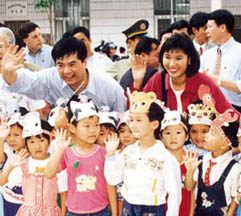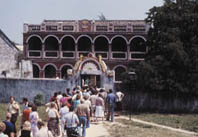There are nine large and medium-sized economically central cities in the Zhujiang River Delta. They are either rapidly approaching or have already achieved  modernization. These cities are not far apart, and are connected by expressways, so it takes only one hour by air-conditioned bus to travel from one city to another. Inhabitants of Dongguan consequently enjoy spending their weekends in Zhuhai, and compatriots from Hong Kong and Macao come to tour Shenzhen, Zhuhai, Huizhou or Zhaoqing at weekends. Convenient transportation and developed facilities have enhanced the inflow of inhabitants. It is confidently predicted that in the near future the cities of the Zhujiang River Delta will be linked together as a whole.
modernization. These cities are not far apart, and are connected by expressways, so it takes only one hour by air-conditioned bus to travel from one city to another. Inhabitants of Dongguan consequently enjoy spending their weekends in Zhuhai, and compatriots from Hong Kong and Macao come to tour Shenzhen, Zhuhai, Huizhou or Zhaoqing at weekends. Convenient transportation and developed facilities have enhanced the inflow of inhabitants. It is confidently predicted that in the near future the cities of the Zhujiang River Delta will be linked together as a whole.
According to experts, the Asia-Pacific Region has become the most economically active region with the greatest potential for further development, that will in future strengthen international cooperation, and form a city group network with several international cities as the core. The city groups in the Zhujiang River Delta and Hong Kong will combine to form one of the most important networks in the Asian-Pacific Region.
According to Doctor Mao Yanhua, a researcher with the Hong Kong, Macao and Zhujiang River Delta Research Center of Zhongshan University, most international metropolises, such as Tokyo, New York and London, have advantageous locations and a dense network structure. In general, they are located at the mouth of a great river on the coast, and have a close knit city, industrial, transportation and information network, jointed by big, medium-sized and small cities and with coastline, river, railway and highway as axes. The Zhujiang River Delta is just like this, having big cities at the mouth of the Zhujiang River on the coast, and the Zhujiang River system inland. There are trunk railways, such as the Beijing-Guangzhou Railway and the Beijing-Kowloon Railway, linking it up with the interior areas. All these aspects provide ideal conditions for the formation of city groups.
To plan and construct the Zhujiang River Delta as a series of city groups, the functions of various cities in the region must be determined, and the departments concerned have started this work. They have selected two centers in the region (Guangzhou and Shenzhen); three metropolitan areas — with the Zhujiang River as the dividing line, to divide the whole region into the east bank area, the west bank area and the central area. In terms of city management, they have divided the whole region into four: an ecologically sensitive area, an open area, a town-intensive area and a metropolitan area. Different standards for public facilities have been worked out in various areas, to promote the modernization of the whole region.
Guangzhou, as central city in the city group, will change function through developing its tertiary industry, such as international finance, trade, scientific research and international business, to become a regional international city.
 Shenzhen will continue to strengthen its functions in finance, foreign trade, commerce, and transfer of international trade. It will also develop an export-oriented economy featuring capital- and technology-intensive industries, to continue to serve as a window on reform and opening and as an experimental ground. In its functions it will gradually realize mutual complementation with Hong Kong, to develop into an international city of influential importance in the city group of the Zhujiang River Delta, and in the eastern area.
Shenzhen will continue to strengthen its functions in finance, foreign trade, commerce, and transfer of international trade. It will also develop an export-oriented economy featuring capital- and technology-intensive industries, to continue to serve as a window on reform and opening and as an experimental ground. In its functions it will gradually realize mutual complementation with Hong Kong, to develop into an international city of influential importance in the city group of the Zhujiang River Delta, and in the eastern area.
Other economic central cities should concentrate on bringing into full play their advantages and characteristics that have been formed over the years, and to be conscientious and thorough in infrastructure construction and ecological protection, so as to create conditions for their sustainable development.
The city group in the central area includes: Foshan, Zhaoqing and Shunde, with emphasis placed on developing the tertiary industry, such as science and technology, finance, commerce, trade, information consultation and development, and tourism combined with weekend holiday-making. The second industry involves auto manufacture, electronics, machinery, beverages, and petrochemicals. In Zhaoqing one can see many beautiful sights such as groves, lakes, hills and caves. The people of Zhaoqing therefore plan to build their city into a “garden-like scenic tourist city.”
The eastern city group includes Dongguan and Huizhou, mainly developing the tertiary industry with foreign trade as the mainstay, the combination of industrial development and scientific research, communications equipment, electronic instruments, energy and chemicals. The largest Sino-foreign joint-venture petrochemical project in the country — the Zhonghai Shell Petrochemical Project — is located in Huizhou.
The western city group includes Zhuhai, Zhongshan and Jiangmen, which will mainly house developing industries that rely on port shipment, such as energy, heavy chemicals, machinery and high-tech bio-pharmaceuticals, tourism, and port trade, with freight transport as the mainstay. Jiangmen is the ancestral home of many overseas Chinese, with more than 3.6 million people of Jiangmen origin — equivalent to the total population of Jiangmen City, residing in more than 100 countries and regions, including Taiwan, Hong Kong and Macao. Attracting overseas investment through overseas Chinese is one of the forms of inviting in overseas capital. Through the overseas Chinese of Jiangmen origin, the distance between Jiangmen and the outside world has been shortened, and the inhabitants of Jiangmen are especially open. They have instituted many festivals and events to attract outside investment, such as spring tea ceremonies, the dragonboat festival, kinfolk reunions, and honor-award gatherings. At present, Jiangmen has granted titles of “honorific citizen” to 284 overseas Chinese who have invested in their ancestral hometown. Among them, the majority now resides in Hong Kong. Most have each invested 30 million yuan.
The people living in the Zhujiang River Delta are fortunate. Although the per capita GDP in the area is not as high as that of the Republic of Korea, Singapore, Hong Kong and Taiwan, known as “four dragons of Asia,” the living standards in the Zhujiang River Delta are in no way inferior. According to Lu Ruihua, governor of Guangdong Province, “Living standards in the Zhujiang River Delta are almost the same as those in Taiwan.” Yu Youjun commented, “I have visited Taiwan, Hong Kong and Singapore, and I feel our housing conditions are equal. In Shenzhen, the per capita housing area is 14 square meters, no lower than that of Taiwan and Hong Kong. There is little gap in scope of diet, and our prices are much lower. The largest gap is in the proportion of inhabitants who own private cars. Another gap is as regards the environment, such as the city comprehensive environment, and traffic and urban management. But I believe that we have achieved more in our environmental protection and greening than has been accomplished in Hong Kong and Taiwan.”